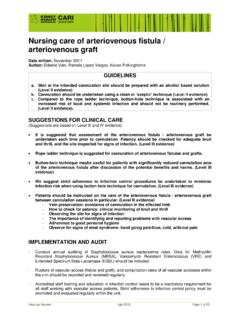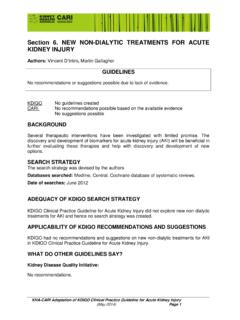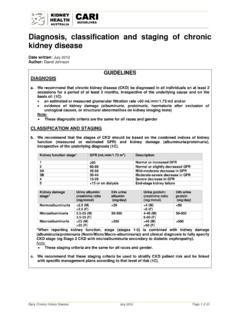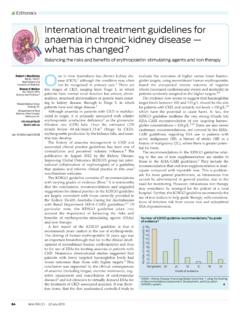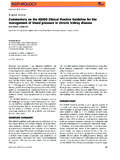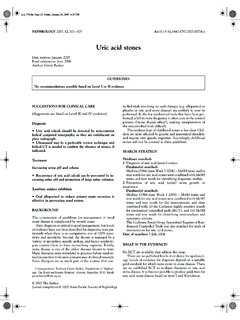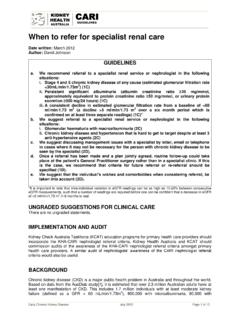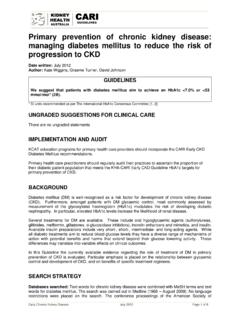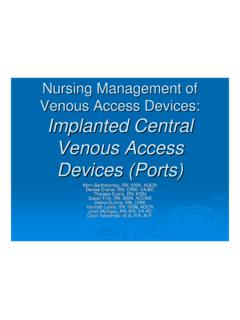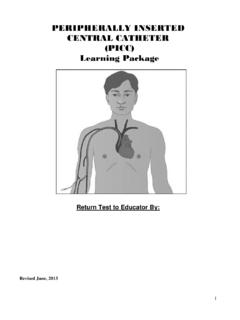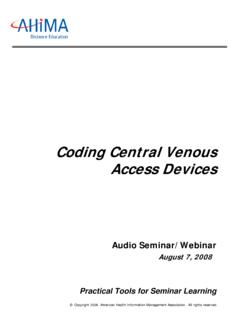Transcription of Insertion of catheters - KHA-CARI Mission
1 _____Vascular Access July 2012 Page 1 of 14 Insertion of catheters Date written: June 2012 Author: Rob MacGinley and Andrew Owen GUIDELINES a. The use of real-time ultrasound guidance is strongly recommended for the placement of haemodialysis catheters and results in improved rates of successful catheter placement, and reduced rates of both haematoma formation and inadvertent arterial puncture. (Level 1). SUGGESTIONS FOR CLINICAL CARE (Suggestions are based on Level III and IV evidence) The adherence to strict aseptic technique is proven to reduce the catheter related bacteraemia rate and all units should therefore audit this practise (Level 3). Tunnelled haemodialysis catheters should be used as they are associated with lower rates of catheter related bacteraemia, catheter dysfunction and vascular damage ( venous trauma, and stenosis) compared to temporary non-tunnelled catheters (Level 3) The right internal jugular vein is the preferred Insertion site with respect to ease of access and lower rates of short and long term complications.
2 (Level 3/4) In ICU settings, subclavian catheter placement has excellent short term outcomes compared to jugular and femoral approaches but has significant long term sequelae recommending against their use (Level3/4) A post procedural chest X-ray following internal jugular or subclavian catheter Insertion should be performed to check placement of the tip below the right atrial/internal jugular junction in subjects where fluoroscopic guidance has not been utilised. (Level 3). IMPLEMENTATION AND AUDIT 1. Need for adequate monitoring of the following: Number of catheter infection to be <5 per 1000 catheter days Minimal reattempts and failed access Pneumothorax and arterial puncture rates to be <1% 2. A strict protocol for aseptic Insertion technique should be implemented, and an audit conducted annually to assess compliance 3. Review of policies and practices regarding CVC Insertion BACKGROUND Though vascular access is best achieved through a fistula with a longer access and patient survival, there are unfortunately a persistent number of patients commencing end-stage renal disease (ESRD) therapy through a temporary or tunnelled cuffed catheter [1].
3 Insertion of these catheters is an invasive procedure with small but definite rates of morbidity and mortality. The patient mix presenting for ESRD therapy will have a variance in venous anatomy or be obese and diabetic patients for instance which _____Vascular Access July 2012 Page 2 of 14 increases the risks for the procedure and limit alternative access like a fistula. This often warrants multiple long term catheters in the life of some patients. These guidelines will review and summarize the current evidence on catheter Insertion ranging from vein localization via real time ultrasound to adequacy of access sites for both short and long term morbidity. Unfortunately as in all disciplines of nephrology, many other components of vascular catheter Insertion have to yet obtain robust evidence and rely on small case based studies for the recommendation seen here.
4 SEARCH STRATEGY Databases searched: MeSH terms and text words for central venous catheter were combined with MeSH terms and text words for haemodialysis, and combined with MeSH terms and text words for Insertion , The search was carried out in Medline (1966 to January 2012). An update search was done in Medline (March 2012) using the same MeSH terms and text words. Date of initial search: January 2012 Date of update search: March 2012 WHAT IS THE EVIDENCE? catheter Insertion The use of real time ultrasound guidance for the placement of haemodialysis catheters was examined by a large systematic review and meta-analysis [2]by the Cochrane group. In 7 trials of 830 catheter placements, ultrasound guidance was associated with improved rates of successful catheter placement ( catheter placement failure RR , P= ); shorter procedural times (mean difference minutes) and reduced rates of both haematoma formation (RR , P= ) and inadvertent arterial puncture (RR , P= ).
5 Procedural time is the time taken (minutes) from skin anaesthesia to successful vein puncture. Ultrasound should ideally be supplemented with fluoroscopic guidance [3, 4] as venographic studies have revealed a significant incidence of central venous stenosis and venous angulation that could complicate blind Insertion [5]. There are, however, case series of successful right internal jugular catheter placement without fluoroscopy [6]. catheter related bacteraemia The common catheter Insertion sites have been evaluated with respect to the risks of catheter related bacteraemia and the rates of venous stenosis. A study of 134 ICU patients[7] showed comparable rates of catheter related bacteraemia between internal jugular and common femoral access sites in the short term. Robust long term data on the risk of catheter related bacteraemia stratified by catheter Insertion site is lacking.
6 In a Japanese surveillance report of catheter use, patients with femoral vein catheterisation reported a higher rate of catheter related bacteraemia of per 1000 catheter days compared with in subclavian and in jugular catheterisation[8]. This conclusion was supported by a recent Cochrane Review [9] where catheter related bacteraemia in long term catheterisation was higher in the internal jugular RR compared to subclavian catheterisation P= In short term catheterisation, femoral access had higher rates of catheter -related bacteraemia RR , catheter related thrombosis RR and catheter colonisation RR compared with subclavian access. In a study of over 10,000 ICU central line insertions, the use of strict aseptic technique resulted in a significant reduction in nosocomial infections, where central line-associated bacteraemia dropped from to per 1000 catheter days (P< ) [10].
7 Strict asepsis should therefore be compulsory for the Insertion of haemodialysis catheters and its implementation should be subject to regular audit. There is no evidence that the use of prophylactic intravenous antibiotics reduces the risk of catheter related bacteraemia [11, 12] and the use of silver-impregnated collagen cuffs on tunnelled catheters has also shown no benefit [13]. This study randomised patients to a control group (dual-lumen tunnelled cuffed catheter [TCC]) and to an experimental group, (TCC with an additional silver-impregnated cuff). There was no significant difference in the infection/day hazard rate of for the control group versus for the experimental group. _____Vascular Access July 2012 Page 3 of 14 central venous stenosis The long term central venous stenosis rate (up to 50%) for haemodialysis catheters that are inserted into the subclavian vein preclude its use except in the rarest of situations [14-16].
8 Short term non-tunnelled catheters have now been shown in multiple small case series to have high rates of venous trauma, thrombosis and stenosis, even within two weeks of use. The use of tunnelled catheters even for the short term patient is preferable, although this may not be feasible in all centres [5, 17-19]. catheter survival The predictors of catheter survival have been reviewed in single centre experience of 812 catheter insertions [20]. The predictors of better outcomes include the right internal jugular Insertion site, being a non-diabetic and first catheter Insertion . Survival times were also greatest for the right internal jugular vein (RIJV) with 633 days compared to 430 days for the left internal jugular vein (LIJV) and 116 days for the femoral vein (FV) The catheter type did not influence catheter survival although case series would suggest that contemporary catheters survive longer than older models [21].
9 The latter studies are however, smaller and industry sponsored. In patients in whom conventional access sites have been exhausted, the placement of catheters via occluded or collateral veins warrants consideration. In a study by Powell et al, [22] 19 patients had their catheter inserted by an interventional radiologist via an occluded or collateral vein while 38 patients (two control groups) had conventional catheter Insertion . There was no short term difference in the rates of catheter survival, catheter flow, infection or procedural complications between the experimental and control groups. In a series of 24 patients, Funaki et al., reported increased rates of catheter dysfunction using these techniques but secondary patency rates were still 100% and 70% at 6 and 12 months respectively[23]. The use of long-term catheters is increasing and in such patients venous access options are often limited.
10 This situation has demanded comparison between the uses of catheter exchange over a guide wire versus an alternative Insertion site. Several small retrospective case series suggest that catheter exchange is a safe, effective and viable option in terms of catheter survival and nosocomial infection rate [22, 24-26]. However, two contemporary studies [27, 28] do not concur with these findings, and this practice warrants further prospective investigation. Beyond the occasional case report, surgical Insertion of haemodialysis catheters has never been trialled in any experimental study and is lacking from any published audit data for Australia. SUMMARY OF THE EVIDENCE It is now standard of care to insert a haemodialysis catheters under real time ultrasound (and preferably fluoroscopic) guidance. The internal jugular vein Insertion site results in the longest catheter survival times and the use of tunnelled rather than temporary catheters produces lower rates of venous thrombosis and trauma even in the short term (<2 weeks).
